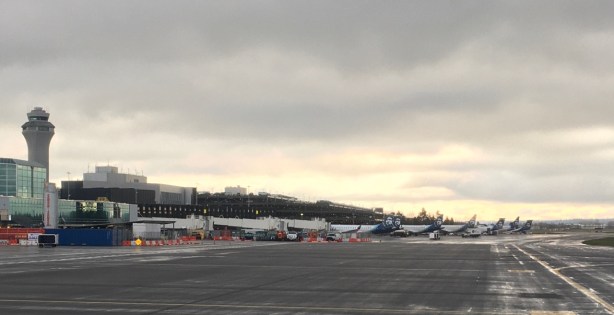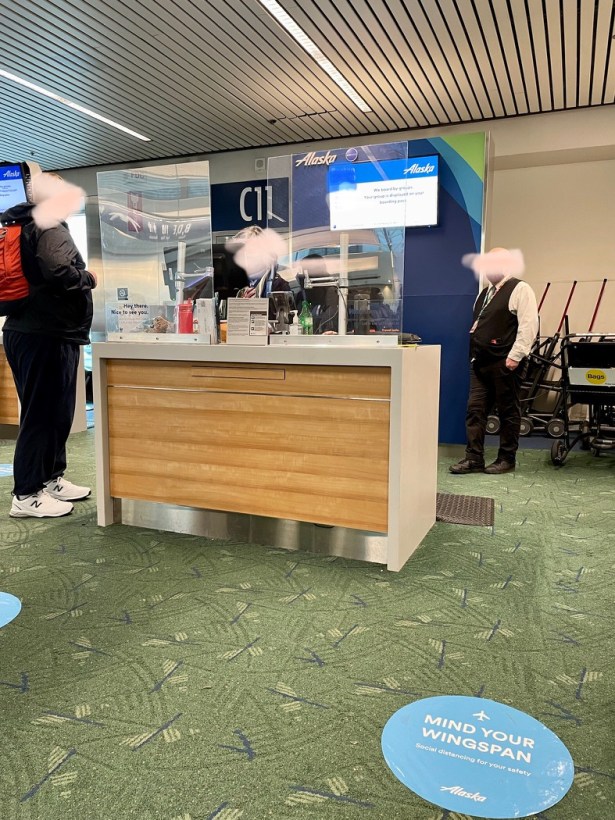This post will benefit those of us who fly in or out of Oregon’s major international hub, PDX. The airport, it is a-changing, and if you think you know it and how to navigate it, but you haven’t traveled much during the pandemic, think again!
Until now (December 2021), perhaps my favorite thing about PDX was the elegant simplicity of all airside (post-security) amenities being accessible to each other. There used to be a connector between this airport’s two sides. Adding 150 feet of space inside the terminal is displacing the old walkway.
R.I.P. airside connector!
The good news is that this generally sensible airport will regain such a connection when the major construction is done. The bad news? That is scheduled for 2023.
As of 2021, travelers need to exit security and re-clear the TSA checkpoint to go from the B/C side to the D/E side. That’s a bummer, and a change, but it makes PDX similar to many other poorly designed airports.
Note: Crossing from B/C to D/E always has been a long-ish walk, and those with difficulty walking should get assistance or allow lots of time here even when the option comes back. Fortunately, most domestic connections don’t require crossing the airport in this way.
Here’s something that had an even bigger impact on me, a person who travels with some mobility limitations due to chronic illness: the walk from check-in to gate before departure, or from gate to baggage claim upon arrival, has grown from manageable to torturous according to my abilities.
This update may also affect families with young children. Little legs on very tired, very young people may also find the new trek difficult.
If you think you already know you can comfortably handle the walking distances at PDX, please look at updated construction maps and reconsider before travel if it’s been awhile since your last transit of this normally pleasant airport.
I flew into PDX in the summer, visiting my dad, and the modern “one way valve” security exit didn’t seem so very different from before. The walk was longer, yes, and around to the side whereas one used to enter and exit the secure area from a central location, but at that point the airport still felt familiar with a slight redirection.
Landing in early December, 2021, however—after an, admittedly, much longer-than-average flight time due to a fierce jet stream—walking from arrival gate to baggage claim felt like personal judgement by a cruel god. I thought I might have to stop and rest at one point. I regretted failing to ask for a wheelchair escort before I was halfway out.
Checking in, just before the New Year, to fly home again, I asked an Alaska Airlines representative if the way in was now as convoluted as the exit route had been.
“For the next four years,” she chirped. I opted to visit the special assistance group over by the windows and take a ride to spare my feet.
If you struggle with walking long distances, I strongly advise electing wheelchair assistance at PDX until its renovations are complete. Arrive very early, and accept the help that is available.
As it happens, there was no free assistance agent to help me at 07:30 on New Year’s Eve, though someone was present with the flock* of empty wheelchairs checking boarding passes and explaining the process.
Lucky for me, they gave us the option of having one of my able-bodied kids push me in an airport-owned chair, so we were off within five to seven minutes. An elderly couple traveling on their own who’d arrived before us was still waiting as we left.
I didn’t ask for an official estimate for how long the process of being assisted might take, but I’d add at least half an hour to one’s airport dawdling allowance if traveling alone with special mobility needs requiring an airport-provided wheelchair and attendant.
It goes without saying that one’s teen may not steer a wheelchair as expertly as an experienced, paid professional. Then again, I’ve had my feet bashed by at least a couple of strangers in the past, so a strong kid who loves you isn’t the worst option at an airport.
The “traffic cop” airport employee who directs passengers into the correct TSA security line did cause us some confusion by pointing to the “Express” lane when we were actually eligible for the “PreCheck” lane.
It’s worth knowing that PreCheck trumps Express as far as convenience goes, so use that lane if your boarding pass indicates you are eligible.
Travelers transiting the airport from one no-longer-connected terminal to another are eligible for “Express” lane priority, which did have a markedly shorter line this December morning when compared with the standard security queue. PreCheck, on the other hand, allows one to leave shoes and light jackets on one’s body, keep liquids and electronics inside one’s bag, etc.
Fortunately, the split between Express and PreCheck was very close to the body scanners and X-ray machines so we backtracked only 15 or 20 feet.
It is possible that simply being in a wheelchair caused the “traffic cop” airport employee to direct us to the Express lane. In the past, I’ve noted that wheelchair assistance often allows one to skip the security queue. If this policy is universal, that could shave off a bit of the time “wasted” waiting for an assist. Then again, I didn’t stop to interrogate the employee in question, so don’t count on cutting the line due to mobility limitations without consulting a higher authority than me.
When I make use of airport assistance in the United States, I do tip any wheelchair attendant $5 per ride.
This is not a mandatory fee—services for travelers with disabilities are the responsibility of places of public accommodation—but it does seem to be expected, particularly in the northeast region. In foreign airports when I’ve relied upon similar services, I’ve gotten baffled looks from employees less accustomed to our tipping culture, with gratuities being politely refused in New Zealand, for example.
If you only occasionally need an airport mobility assist, and haven’t typically taken advantage of one at PDX, reconsider your habits there for trips from 2022 to 2024. If your toes are anything like mine, they will thank you!
Airport assistance is a public good meant to serve all of us who travel; don’t be ashamed to take advantage of services designed to allow everyone equal access to the world.
♦
*What is the correct plural noun for wheelchairs, I wonder? If I get to choose, let’s go with a “roller” of wheelchairs.







